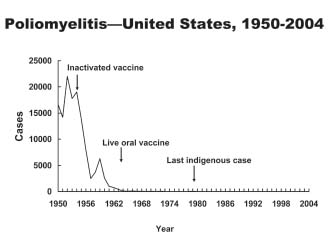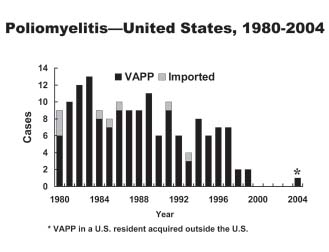Polio epidemiology and demographics: Difference between revisions
Rim Halaby (talk | contribs) No edit summary |
Joao Silva (talk | contribs) No edit summary |
||
| Line 1: | Line 1: | ||
__NOTOC__ | __NOTOC__ | ||
{{Polio}} | {{Polio}} | ||
{{CMG}} | {{CMG}}; {{AE}} {{JS}} | ||
==Overview== | ==Overview== | ||
Revision as of 03:01, 2 September 2014
|
Polio Microchapters |
|
Causes |
|---|
|
Diagnosis |
|
Treatment |
|
Case Studies |
|
Polio epidemiology and demographics On the Web |
|
American Roentgen Ray Society Images of Polio epidemiology and demographics |
|
Risk calculators and risk factors for Polio epidemiology and demographics |
Editor-In-Chief: C. Michael Gibson, M.S., M.D. [1]; Associate Editor(s)-in-Chief: João André Alves Silva, M.D. [2]
Overview
Because of polio eradication efforts, the number of countries where travelers are at risk for polio has decreased dramatically. The last documented case of wild polio virus-associated paralysis in a US resident traveling abroad occurred in 1986 in a 29-year-old vaccinated adult who had been traveling in South and Southeast Asia. In 2005, an unvaccinated US adult traveling abroad acquired vaccine-associated paralytic poliomyelitis after contact with an infant recently vaccinated with oral polio vaccine.
Epidemiology and Demographics
Occurrence
At one time poliovirus infection occurred throughout the world. Transmission of wild poliovirus was interrupted in the United States in 1979, or possibly earlier. A polio eradication program conducted by the Pan American Health Organization led to elimination of polio in the Western Hemisphere in 1991. The Global Polio Eradication Program has dramatically reduced poliovirus transmission throughout the world. In 2005, only 1,948 confirmed cases of polio were reported globally and polio was endemic in six countries.
Poliovirus infection typically peaks in the summer months in temperate climates. There is no seasonal pattern in tropical climates.
Secular Trends in the United States
Before the 18th century, polioviruses probably circulated widely. Initial infections with at least one type probably occurred in early infancy, when transplacentally acquired maternal antibodies were high. Exposure throughout life probably provided continual boosting of immunity, and paralytic infections were probably rare. (This view has been recently challenged based on data from lameness studies in developing countries.)
In the immediate prevaccine era, improved sanitation allowed less frequent exposure and increased the age of primary infection. Boosting of immunity from natural exposure became more infrequent and the number of susceptible persons accumulated, ultimately resulting in the occurrence of epidemics, with 13,000 to 20,000 paralytic cases reported annually.
In the early vaccine era, the incidence dramatically decreased after the introduction of inactivated polio vaccine (IPV) in 1955. The decline continued following oral polio vaccine (OPV) introduction in 1961. In 1960, a total of 2,525 paralytic cases were reported, compared with 61 in 1965.
The last cases of paralytic poliomyelitis caused by endemic transmission of wild virus in the United States were in 1979, when an outbreak occurred among the Amish in several Midwest states. The virus was imported from the Netherlands. From 1980 through 1999, a total of 152 confirmed cases of paralytic poliomyelitis were reported, an average of 8 cases per year. Six cases were acquired outside the United States and imported. The last imported case was reported in 1993. Two cases were classified as indeterminant (no poliovirus isolated from samples obtained from the patients, and patients had no history of recent vaccination or direct contact with a vaccine recipient). The remaining 144 (95%) cases were vaccine-associated paralytic polio (VAPP) caused by live oral polio vaccine.
In order to eliminate VAPP from the United States, ACIP recommended in 2000 that IPV be used exclusively in the United States. The last case of VAPP acquired in the United States was reported in 1999. In 2005, an unvaccinated U.S. resident was infected with polio vaccine virus in Costa Rica and subsequently developed VAPP. Also in 2005, several asymptomatic infections with a vaccine-derived poliovirus were detected in unvaccinated children in Minnesota. The source of the vaccine virus has not been determined, but it appeared to have been circulating among humans for at least 2 years based on genetic changes in the virus. No VAPP has been reported from this virus.

